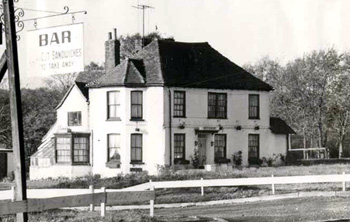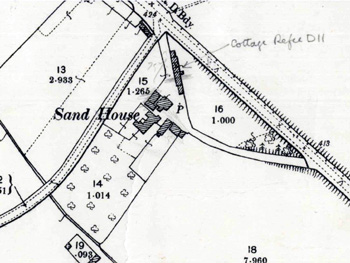The Sandhouse Inn Heath and Reach

The Sandhouse Inn about 1970
The Sandhouse Inn: Watling Street [also The Peacock]
The Sandhouse, also Sand House, was a listed building and stood on Watling Street (the A5) in the vicinity of Sandhouse Cottages. The former Department of Environment listed the building in 1974 and reckoned it to be 18th century. Their description was as follows: "Whitewashed brick. Two storeys. Hipped old clay tile roof. Three sashes in cased frames, the central first floor one being a combined pair".
The earliest record held by Bedfordshire & Luton Archives & Records Service is a lease for eleven years from Edmund Williamson of Husborne Crawley to Latham Arnold of London, tobacconist, of a cottage called the Sand House, an acre of land and two sand pits for a rent of £3/10/0 per annum in 1734 [M1/9/1]. By 1759 the Sand House may have become an inn as in that year it was leased by Talbot Williamson to John Bates of Leighton Buzzard, innholder, for £5 per annum [M1/9/2].
The accounts of the Overseers of the Poor for Heath and Reach for 1762 note: notes: "Payed Thomas Hanwell what he spent at the Sandhouse when the travelling woman was there, as he went to see about it: 4d" [P84/12/2]. This seems to imply that the travelling woman was staying at the inn and Hanwell, presumably the overseer, claimed expenses from the parish for making the visit to her. Maureen Brown in Transactions of Leighton Buzzard and District Archaeological and Historical Society Number 3 (2009) noted that in January 1781 Bates took out insurance with the Royal Exchange Company on his dwelling called the Sand House and known by the sign of the Peacock, insuring it for £360. The policy listed two stables and a granary with two further stables nearby, all built of brick and tiled. Another newly built stable and a combined barn and stable adjoined the granary and they were timber built and tiled.
The earliest countywide licensing returns, those for 1822 to 1828, contain a public house called the Peacock, licensed by a Joseph Powell. When Heath and Reach was inclosed in 1841 Joseph Powell was listed as owning a close of land on Watling Street, the Sand House and a public house [ABookN]. On the section of the inclosure map shown below Powell's land is coloured green and numbered 3. Maureen Brown notes that Powell, a veterinary surgeon, married John Bates' daughter who inherited the house and inn in 1835.

The Sandhouse in 1841
Also dating from 1841 is an apprenticeship indenture [HN2/4] in which licensee Joseph Powell's son Robert described as of "The Old Peacock Inn, Sandhouse in the Hamlet of Heath and Reach" was bound apprentice to John Felix Matthews of Leighton Buzzard, carpenter, joiner, cabinet maker and upholsterer for seven years. Joseph Powell is deacribed as innholder and farrier.
The Peacock is last mentioned in any directory in 1871. By 1876 former licensee Charles Powell is listed simply as a veterinary surgeon suggesting that the public house closed between these two dates. The 1871 census reveals that he was 46 and a widower.
The Rating and Valuation Act 1925 ordered every piece of land and building in the country to be assessed to determine the rates to be paid on it. Heath and Reach was assessed in 1927 and the valuer visiting the Sandhouse [DV1/C233/48-49] noted that it was a private house, owned and occupied by Charles A.Powell, a veterinary surgeon, and stood in 0.456 of an acre. The 1901 census lists a Charles Powell, veterinary surgeon, at the Sandhouse. He was then twenty seven and if he is the same man as the Charles A.Powell in 1927 he would then be 53 years of age.

The Sand House on the Ordnance Survey 2nd edition map of 1901
Accommodation comprised three reception rooms, a kitchen and scullery downstairs with five bedrooms and a dressing room above - "no bath". An attic box room lay above that. A brick and tile barn stood outside, which the valuer observed "could be used as Garage". There was also a "good; brick and tile barn used as Surgery" measuring 12 feet by 14 feet and an old brick and tile cottage which was unused ("unoccupied for years"). A brick and tile range consisted of a brewhouse, a relic from inn days, and "now used as washhouse" and a laundry ("moderate"). A brick and tile barn with a cement floor used as coachhouse and garage completed the picture.
The valuer commented: "Long way out" and "Stands back from Watling Street good farmhouse type. Isolated position". By the time it was listed in 1974, and probably from at least the 1960s, the Sandhouse was, once again, an inn, latterly called the Tavistock. Sadly it is no more. It was destroyed by fire in 1987 and was eventually de-listed in September 1993.

The site of the Sand House June 2008
References:
- M1/9/1: Lease for eleven years of a cottage called the Sand House: 1734;
- M1/9/2: Lease for eleven years of a cottage called the Sand House: 1759;
- P84/12/2: Heath & Reach overseers account mention the Sand House: 1762;
- WW2/AR/CO/2/2: 5 high explosive bombs dropped in open ground near Sandhouse: 1940;
- PL/PH2/5-6: photographs: 1960s
List of Licensees: note that this is not a complete list; entries in italics refer to licensees where either beginning or end, or both, dates are not known:
1759: John Bates;
1822-1862: Joseph Powell;
1869-1871: Charles Powell